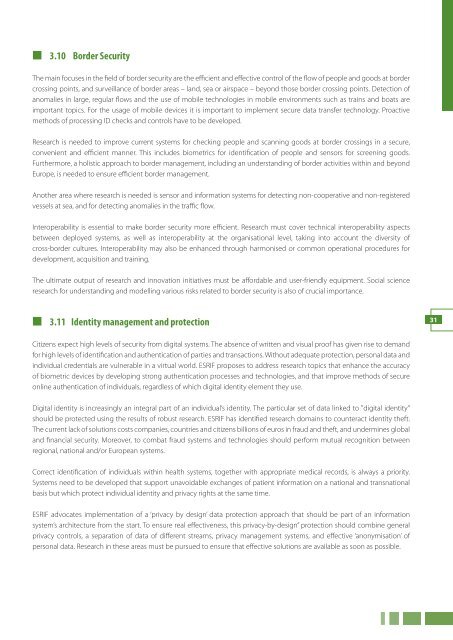I527-290 ESRIF Final Report (WEB).indd - European Commission
I527-290 ESRIF Final Report (WEB).indd - European Commission
I527-290 ESRIF Final Report (WEB).indd - European Commission
Create successful ePaper yourself
Turn your PDF publications into a flip-book with our unique Google optimized e-Paper software.
3.10 Border Security<br />
The main focuses in the fi eld of border security are the effi cient and eff ective control of the fl ow of people and goods at border<br />
crossing points, and surveillance of border areas – land, sea or airspace – beyond those border crossing points. Detection of<br />
anomalies in large, regular fl ows and the use of mobile technologies in mobile environments such as trains and boats are<br />
important topics. For the usage of mobile devices it is important to implement secure data transfer technology. Proactive<br />
methods of processing ID checks and controls have to be developed.<br />
Research is needed to improve current systems for checking people and scanning goods at border crossings in a secure,<br />
convenient and effi cient manner. This includes biometrics for identifi cation of people and sensors for screening goods.<br />
Furthermore, a holistic approach to border management, including an understanding of border activities within and beyond<br />
Europe, is needed to ensure effi cient border management.<br />
Another area where research is needed is sensor and information systems for detecting non-cooperative and non-registered<br />
vessels at sea, and for detecting anomalies in the traffi c fl ow.<br />
Interoperability is essential to make border security more effi cient. Research must cover technical interoperability aspects<br />
between deployed systems, as well as interoperability at the organisational level, taking into account the diversity of<br />
cross-border cultures. Interoperability may also be enhanced through harmonised or common operational procedures for<br />
development, acquisition and training.<br />
The ultimate output of research and innovation initiatives must be aff ordable and user-friendly equipment. Social science<br />
research for understanding and modelling various risks related to border security is also of crucial importance.<br />
3.11 Identity management and protection<br />
Citizens expect high levels of security from digital systems. The absence of written and visual proof has given rise to demand<br />
for high levels of identifi cation and authentication of parties and transactions. Without adequate protection, personal data and<br />
individual credentials are vulnerable in a virtual world. <strong>ESRIF</strong> proposes to address research topics that enhance the accuracy<br />
of biometric devices by developing strong authentication processes and technologies, and that improve methods of secure<br />
online authentication of individuals, regardless of which digital identity element they use.<br />
Digital identity is increasingly an integral part of an individual’s identity. The particular set of data linked to "digital identity"<br />
should be protected using the results of robust research. <strong>ESRIF</strong> has identifi ed research domains to counteract identity theft.<br />
The current lack of solutions costs companies, countries and citizens billions of euros in fraud and theft, and undermines global<br />
and fi nancial security. Moreover, to combat fraud systems and technologies should perform mutual recognition between<br />
regional, national and/or <strong>European</strong> systems.<br />
Correct identifi cation of individuals within health systems, together with appropriate medical records, is always a priority.<br />
Systems need to be developed that support unavoidable exchanges of patient information on a national and transnational<br />
basis but which protect individual identity and privacy rights at the same time.<br />
<strong>ESRIF</strong> advocates implementation of a ‘privacy by design’ data protection approach that should be part of an information<br />
system’s architecture from the start. To ensure real eff ectiveness, this privacy-by-design” protection should combine general<br />
privacy controls, a separation of data of diff erent streams, privacy management systems, and eff ective ‘anonymisation’ of<br />
personal data. Research in these areas must be pursued to ensure that eff ective solutions are available as soon as possible.<br />
31

















